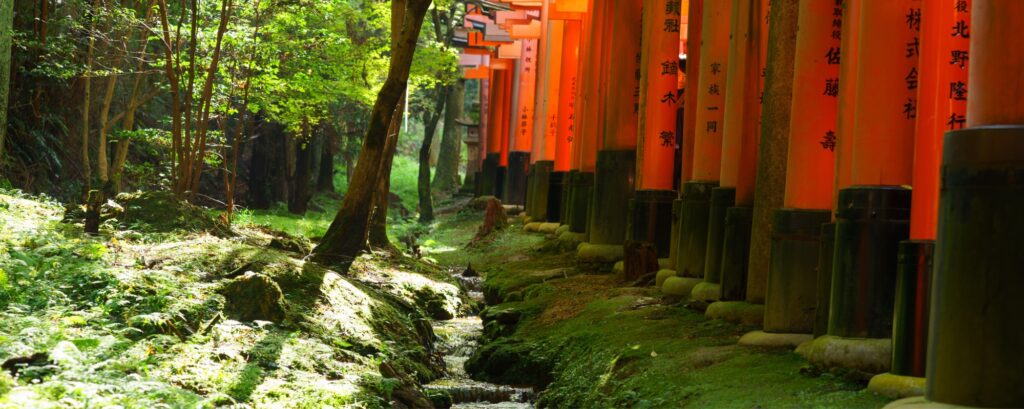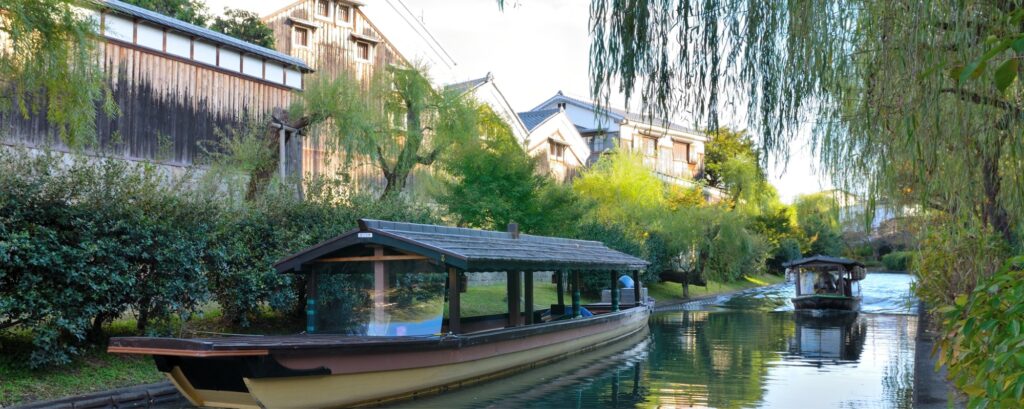
Sake
Sake of Fushimi, Kyoto – one of the largest Sake production area
There are there representative Sake making regions in Japan. They are Nada (灘) of Hyogo prefecture (兵庫県), Fushimi (伏見) of Kyoto prefecture (京都府), and Saijo (西城) of Hiroshima prefecture (広島県). This article focuses on Fushimi of Kyoto prefecture exploring its geographical advantages and history.
Contents
Fushimi and its surroundings

Fushimi is blessed with abundant high-quality water. How can it be possible?
While water flows through the Momoyama Hills, it gets highly purified in the underground and re-appears on the foot of the hills. This is exactly the water source of Fushimi.
Availability of high quality water is definitely one of the critical factors to make Fushimi a representative Sake production site. Gokonomiya Shrine (御香宮神社) in Fushimi continues to spring ‘Gokosui’ (御香水), literally meaning ‘ precious good-scented water’. Gokosui is selected as one of the best 100 waters of Japan. In Japanese, the expression of Gokosui would have a connotation that it is blessed and provided by god.
Fushimi is currently written as 伏見 (meaning: watching the flow), however, the ancient spellings were 伏水 (meaning: water flow). Needless to say, its initial names express the tighter connection with the area and the abundance of underground water.
Characteristics of Sake from Fushimi

One critical element to determine the taste of Sake is, without doubt, water as it consists of the major part of the product.
Regarding the quality of water, what matters is the volume of minerals, in brief, the total volume of calcium and magnesium contained in the water. The volume of minerals determines how hard the water is.
Water containing less amount of minerals is considered as soft water, whereas water with rich contents of minerals is called hard water. Water in Fushimi falls onto just in the middle of hard water and soft water. Sake made from this type of water is believed to have delicate, mild and soft textures.
Sake from Nada is often compared with that from Fushimi because Sake from Nada is made from hard water, water rich in minerals, and it turns into rather dry and acidic Sake.
This is why Sake from Nada is often called Otoko-zake (男酒), manly Sake, while Sake from Fushimi is called Onna-sake (女酒), feminine Sake.
Why do mineral contents influence on the flavours of Sake? Minerals play an important role in activating koji-mold. When the water contains high volume of minerals, the Kobo becomes more active so it accelerates the fermentation process. It is interesting to know that water, a transparent liquid with no taste has such a huge influence in the outcome of Sake flavours. Fushimi – Nada comparison tells the essence of Sake production in a simple way. If you do not want to read a thick book full of Japanese terms, but still want to know the basics and real examples of Sake, I recommend you research on these two production sites for a simple comparison.
Interesting spots to discover in Fushimi in relation to Sake

Gekkeikan Okura Sake Museum (月桂冠大倉記念館)
As of October 2022, the museum is open again for individual visits of facility tour (exhibition room and tasting). The facility tour for groups larger than 9 people is suspended. For further information, please refer to the website below. You can explore the history of Sake making in Fushimi and the history of its pioneer, Gekkeikan.
https://www.gekkeikan.co.jp/enjoy/museum/
Kizakura Kappa Country
Kizakura Kappa Country is a restaurant / bar to serve freshly made Sake and beers.
Kizakura Museum which is also called ‘Fushimi Gura’ is located about 10 mins ride from the Kappa Country. The restaurant, Kizakura Kappa Country, is open. Unfortunately, museum visit has been suspended since the pandemic. To check re-openings and make reservations, please refer to the following website.
Restaurant https://kizakura-brewery.com
Museum https://kizakura.co.jp/en/husimigura/
Fushimi Yume Hyakushu (伏見夢百衆)
Fushimi Yume Hyakushu is a café + souvenir shop opened at ex-headquarter building of Gekkeikan. It provides not only Sake, but also sweets and other local products from 15 breweries. Without visiting each brewery, you could taste a variety of Sake from Fushimi.
https://www.smartmagazine.jp/kansai/article/meal/4571/ (in Japanese)
https://sake-5.jp/husimiyumehyakusyuu/ (in Japanese)
Gokonomiya Shrine (御香宮神社)
The shrine displays all types of Sake made in Fushimi in barrels. The water naturally springs inside the shrine premises, and we can taste the water on our visit.
http://gokounomiya.kyoto.jp (in Japanese)
Kyoto is one of the most popular destinations for foreign tourists to Japan. If you happen to visit Kyoto, why don’t you visit Fushimi to also discover the history of Sake to better enjoy your next drink? Through the dive into the world of Sake, you might find the history and culture of Kyoto even more interesting.
ikki is looking for a partner who can post your knowledge or activity on our media. If you are interested please contact us through CONTACT page.







